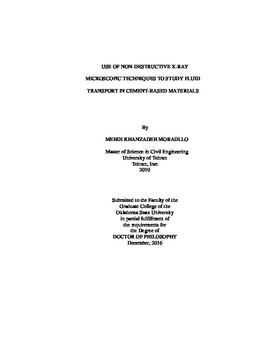| dc.contributor.advisor | Ley, Matthew Tyler | |
| dc.contributor.author | Khanzadeh Moradllo, Mehdi | |
| dc.date.accessioned | 2018-03-13T18:15:56Z | |
| dc.date.available | 2018-03-13T18:15:56Z | |
| dc.date.issued | 2016-12 | |
| dc.identifier.uri | https://hdl.handle.net/11244/54554 | |
| dc.description.abstract | Most of the urban infrastructure is made of concrete with a design service life of over 50 years. Unfortunately, many concrete structures suffer from premature deterioration due to durability issues, most commonly caused by corrosion. The external penetration of ions into cementitious materials is the primary factor influencing the long-term durability of concrete structures. Current test methods to study ion transport in cement-based materials are typically destructive, time consuming, labor intensive, and have a poor spatial resolution to study complex transport phenomenon and capture the effect of complex geometries on fluid transport. In addition, there is little knowledge of the dynamic process of fluid penetration into cement-based materials because few experimental techniques are able to give quantitative spatial measurements of the fluid movement without damaging the sample. This study aims to develop a systematic approach to use micro X-ray fluorescence (microXRF) and Transmission X-ray microscopy (TXM) to study ion transport in different cementitious systems. Examples were shown where these powerful, non-destructive techniques can identify the influence of local abnormalities on ion transport with high spatial resolution and can image the early age combined ion transport mechanisms in real time. The current study uses these techniques to evaluate and compare the time-dependent resistance of different alternative cementitious materials (ACMs) to ion penetration. In addition, the effect of degree of saturation, which is a crucial factor in durability of cement-based materials, on ion penetration into partially-saturated samples were investigated by using the developed X-ray imaging techniques. Furthermore, the performance of silane treatments, which is a commonly used surface treatment to reduce fluid entry into concrete was evaluated by microXRF. Also, the effective lifespan of this treatment in concrete bridge decks was determined. The use of developed techniques and observed results from this study helps to expand our understanding of ion transport in cement-based materials and to greatly improve the current models of mass transport and service life predictions of the concrete. This can help a large amount of money to be saved in repair, maintenance, and management of concrete structures. | |
| dc.format | application/pdf | |
| dc.language | en_US | |
| dc.rights | Copyright is held by the author who has granted the Oklahoma State University Library the non-exclusive right to share this material in its institutional repository. Contact Digital Library Services at lib-dls@okstate.edu or 405-744-9161 for the permission policy on the use, reproduction or distribution of this material. | |
| dc.title | Use of non-destructive x-ray microscopic techniques to study fluid transport in cement-based materials | |
| dc.contributor.committeeMember | Russell, Bruce W. | |
| dc.contributor.committeeMember | Hartell, Julie Ann | |
| dc.contributor.committeeMember | Hanan, Jay C. | |
| osu.filename | KhanzadehMoradllo_okstate_0664D_14931.pdf | |
| osu.accesstype | Open Access | |
| dc.type.genre | Dissertation | |
| dc.type.material | Text | |
| thesis.degree.discipline | Civil Engineering | |
| thesis.degree.grantor | Oklahoma State University | |
